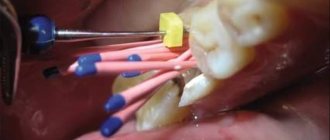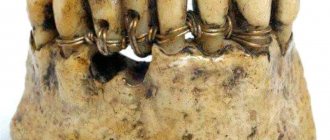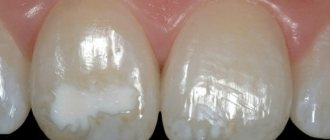Might be interesting:
Colmar
Bordeaux
Blois (France)
Paris
all cities
Sapphire braces from Cassis
There are several types of sapphire braces from Cassis, differing in their physical and technical properties. The most popular among them are Perfect, Aesthetic, Saphire-Miso. Perfect sapphire braces have a polished groove for smooth gliding, which facilitates correction and helps reduce treatment time. They are considered the most durable models.
Aesthetic sapphire braces are often called chameleons, as they tend to change their color in accordance with the characteristics of the tooth enamel. A significant advantage is also the ease with which they are removed at the end of orthodontic treatment, without leaving chips of the tooth enamel. Made from solid single crystal, Saphire-Miso braces are characterized by complete transparency.
The choice of system for treatment is largely determined by the clinical case. In case of complex malocclusion, some models of aesthetic braces may be ineffective. There are also a number of contraindications for which lingual models are unacceptable.
Whatever model of braces is taken as the basis for orthodontic treatment, to obtain a high-quality correction result, the professional qualities of the orthodontist are a priority. Butorina Irina Aleksandrovna is a specialist whose opinion is very competent in matters of bite correction. It will reliably clarify all the nuances of the anomaly and help find the most optimal solution to the problem.
Story
The settlement on the site of Cassis was founded by the Ligurians in the 6th century BC. Also, a fishing village existed here both during the founding of the Greek colonies and the existence of the Roman Empire. In the Middle Ages, barbarian invasions led to the construction of the castle.
Cassis harbor
In the 13th century, Cassis began to belong to the lords of Les Baux de Provence. In the 15th century, the village became the property of the Provençal counts. Cassis now thrives thanks to winemaking, tourism and fishing.
Features of aesthetic models
The material from which they are made has a great influence on the cost of orthodontic structures. Despite the fact that the most affordable are the classic metal models, they have limited use among public people or those who value the aesthetic side of treatment. These braces significantly spoil the appearance of your smile. Ceramic models are noticeably more attractive in this regard. In them, metal parts are replaced with ceramics, the arc is also white.
Sapphire models look even more aesthetically pleasing. Created using jewelry technology, they resemble jewelry that sparkles in the mouth when light hits them. All sapphire braces have the following characteristics:
- high aesthetic properties;
- hypoallergenic;
- resistance to coloring foods;
- low invasiveness due to the smooth surface and rounded shape.
However, their use slightly increases the duration of treatment. In addition, in severe clinical cases they may be ineffective.
, Cassis braces occupy a prominent place . In addition to various orthodontic structures, the company manufactures and sells all types of related products and instruments, which simplifies the installation process.
Food
Cassis offers superb gastronomy where seafood meets the flavors of Provence, seasonal vegetables and excellent white wines. In restaurants in the harbor you can try fresh fish of the following types: sardines, tuna, sea bass, sea bream, mullet, eel, as well as the following seafood: cuttlefish, mussels, squid. It is logical that the most delicious Bouillabaisse is prepared here.
Creme de Cassis, a sweet blackcurrant liqueur, is very popular in Cassis.
Cassis
Arcs
The brand's products, which are made from various materials, are orthodontic products used to correct a person's bite. Several types of structures have been developed from steel, thermal arcs, nickel, titanium. In addition, the company produces Bio Active and Bio Age arches, which are popular in modern dentistry.
In addition, Cassis produces structures made of titanium-molybdenum, which help to achieve a uniform load on the jaw and have additional bends that distribute the load. The structures include copper inserts. Such arches are combined with bracket systems.
Cassis products include arches with loops, with posts or loops. The variety allows you to choose the most appropriate option based on the clinical situation and orthodontic problem.
Implants
Used to provide reliable fastening and support for teeth and dentures. They are made of titanium alloys, which guarantee high-quality fastening and safe screwing into the gum cavity.
Cassis produces products that have anatomical similarities to natural tooth roots, are made from hypoallergenic materials, and also have high levels of strength and quality. Thanks to the sharp and thin thread, there is minimal damage to the gum tissue and easy installation of the structure.
Used for various types of soft tissue intrusion. After applying the structure, there is no change in the state of the angle of the teeth, which is an advantage among other structures.
Bandage rings
The production of bandage rings is carried out by manufacturing structures for all parts of the jaw. At the same time, the design of the bandages almost completely coincides with the anatomical features of the patient’s jaw, therefore it penetrates deeply into the tooth and fixes the crowns.
To improve fixation and fastening, the product is equipped with a rough surface, as well as laser marking. The quality of the structure and its long shelf life are due to the spot welding system of the structure. In addition, it is possible to attach brackets and hooks to the system.
Tube locks
| Click to sign up for a FREE consultation |
Manufactured to improve archwire fixation. The material for the structure is steel, which has 1-2-3 holes, which subdivide the types of locking tubes. The product provides an easy solution to dental problems and access to the problem area.
Attractions
Although the fishing village has ancient origins, most of the buildings in Cassis date from the 17th and 18th centuries. In addition to walking along the harbor, which is one of the most beautiful places in this town, you can also explore the picturesque streets where you can see several stone fountains and ancient chapels, and climb the hill where the 19th century cathedral and the 17th century town hall are located.
Fishing boats in the harbor
The harbor is a small bay full of cute fishing boats and surrounded by colorful houses that are reflected in the water of the Mediterranean Sea.
Not far from the harbor there is a tiny sand and pebble beach framed by cliffs.
Calanques in Cassis
Calanques are small picturesque bays and coves formed by erosion in limestone rocks. In the vicinity of Cassis there are many similar bays with beautiful sandy beaches and clear turquoise water.
Chateau de Cassis
Chateau de Cassis is a medieval castle dating back to the 13th century and once inhabited by Carolingian descendants. It is now a private hotel and is not open to the public. The castle sits atop a steep sea cliff overlooking the village and the sparkling Mediterranean Sea. The origins of this ancient structure go back to the early Middle Ages (approximately 9th century).
Dependence of the price of braces on the method of attachment
Several factors influence the cost of braces treatment. First of all, technical features. Based on the method of attachment in the oral cavity, braces are divided into vestibular, which are fixed to the outer surface of the tooth, and lingual, which are installed on the inner surface of the teeth. Their operation remains invisible to others, which is a significant advantage for the patient who values the aesthetic side of the treatment. However, the disadvantage of such designs is a longer period of adaptation, the presence of diction disorders, and difficult care. The price of such brace systems significantly exceeds the cost of vestibular models.
Might be interesting:
Brest
Louvre
France
Grenoble
all cities
Sights of Cassis:
Oratorios
Before the French Revolution, Cassis depended on the Bishop of Marseille. At that time, the community of Cassis was very religious. The modern city has preserved much of the cultural heritage of that time, including the many oratories that line the streets of Cassis.
As a rule, oratorios are located along the road or made in the form of a pointed or, sometimes, semicircular arch - a niche in the wall. Usually they are complemented by a forged cross. Some still have sculptures dedicated to one or another saint.
Today in Cassis you can count 11 such oratorios: Oratoire de la Vierge, Oratoire de Sainte Marie-Madeleine, Oratoire de l'Enfant Jésus, Oratoire de Saint Joseph, Oratoire de Saint Antoine de Padoue, Oratoire de Saint Charles Borromée, Oratoire de Saint Lazare , Oratoire de Saint Vincent, Oratoire de Notre Dame des Sept Douleurs, Oratoire de Saint-Luc, Oratoire de la Vierge.
Chapels of Cassis
Of the 12 chapels located in Cassis in the 19th century, 4 have survived to this day:
City Hall Chapel
Chapelle de l'Hôtel de Ville. It is located on the second floor of a building (posal of the mayor's office) dating back to 1649. The chapel features a richly decorated ceiling. The stone altar supports an ancient crucifix. The chapel is included in the list of historical monuments. You can visit the inside of the temple only on “National Heritage Days” or on certain days when particularly significant monuments throughout France are open to the public.
Chapel of St. Anna
Chapelle Sainte-Anne. Located on rue de Belloy, this chapel was built after 1870. You can only go inside during National Heritage Days.
Chapel of St. Cross of Jerusalem
Chapelle Sainte-Croix de Jérusalem. Surrounded by cedar trees on the northeast side of Cassis, this chapel dates back to the 18th century. During the French Revolution it was destroyed, but rebuilt in 1850-52. Today the temple is closed to the public, although each year the chapel is opened to pilgrims for a religious ceremony on September 14, during the Festival of the Holy Cross.
Chapelle de Port-Miou
This small chapel was built in 1649 and is dedicated to the Virgin Mary. It was built in honor of deliverance from the plague epidemic and was consecrated under the name Notre-Dame de Santé. In 1720, following a new and much more severe plague epidemic, the temple became a place of annual pilgrimage on the first Sunday in July. During the French Revolution it was sold, the building gradually fell into disrepair, and in 1847 the chapel was demolished to make way for a new quarter. It was rebuilt in 1848, but was poorly maintained, and a century later it was in a terrible state of disrepair when the association took responsibility for a complete restoration of the building, which took about 20 years.
Procession du voeu
The procession is held annually on 1 Sunday, starting at 4 am until sunrise.
Notre Dame de la Mer et à Saint Roch
Officially opened in 1875, the church is dedicated to St. Michael, Virgin Mary and St. Rohu. This was the third church built in Cassis. Made of stone in a neo-Romanesque style, it consists of three naves, is 32 m long and 18 m wide and can accommodate up to 400 seats. The church was restored in 1958.
Port of Cassis:
Other attractions in Cassis:
Fountain 4 Nations
The newly made fountain is a copy of the previous one, built in 1690. The monument reproduces the Parisian fountain made in 1686 in honor of the victories of Louis XIV. It was so skillfully made that when Parisians came to Cassis, they noted in their diaries: “he who has seen the fountain in Paris has seen nothing until he sees the fountain in Cassis.” This phrase was reworked by Frédéric Mistral in the early 20th century, eventually becoming the city's emblem.
According to local history, the original fountain was accidentally broken in 1785 by a Catalan fisherman who climbed to its top to better view the summer festival dedicated to St. John.
Baranyon Fountain
Located in the center of the park, this fountain is made in honor of Pierre Baragnon, owner of the mansion in Fontcreuse and general councilor of the canton for 20 years. Thanks to his efforts, water from the Marseille canal was brought to Cassis in 1892.
City Hall of Cassis
The current city hall was built in the 17th century as a private mansion for Désiré de Moustiers, former consul in Marseille. The building changed hands several times until the municipality of Cassis bought it in 1938. Since 1945, it has housed the city hall.
Since 1984, the building has been listed as a historical monument, mainly due to the interiors: the Salon d'Honneur with its decorated ceiling, Renaissance fireplace, chapel with ornamented ceiling, façade with Louis XIII windows and an elegant hall with staircase and balustrade. During the restoration work carried out in 1998, it was possible to discover a number of elements preserved from the Middle Ages: they can be seen through the windows on the ground floor.
Cassis Castle
Cassis Castle (CHÂTEAU DE CASSIS) is a 13th - 14th century fortress, most likely built on the remains of the first building from the 8th century. Since 1232, Castrum belonged to the influential Les Baux family, who also owned the Aubagne fiefdom and the Roquefort estate. It was inside Castrum that medieval Cassis developed, protected by fortress walls from attacks by barbarians and bandits. At the end of the 15th century, more than 250 people lived in the fortress.
In 1524, the fortress was taken by the troops of Charles V, the citadel was gradually abandoned in favor of a town that stretched along the seashore and became a military port. The castle has been resold several times since 1896, remaining in private ownership and turned into a luxurious residence.
Villa Ariana
VILLA L'ARIANE - This Italian-Provençal-style country house belonged to a family of winemakers from Cassis. The villa has been restored by the municipality. Now there is a Public Library and, in the old greenhouse, a Music School, opposite a decorative garden with a swimming pool.
Moorish villa
VILLA MAURESQUE is adjacent to the castle. The building was built at the beginning of the 20th century, and the name comes from the style of the villa, reminiscent of the colonial buildings in Algeria that were built at that time. Along with the castle, the villa was bought by an American who fell in love with Cassis. After his death, the building passed from hand to hand when, finally, in 1979, the Municipality bought the building. The villa is currently closed to the public due to restoration work being carried out on the building.
Fishing court
TRIBUNAL DE PÊCHE. Situated along the port on quai Barthélemy, the fish court testifies to an activity that has long been important in the commune: the struggle of the inhabitants of Cassis to separate them from the “oppressive, tyrannical, expensive, suspicious and insulting” jurisdiction of the conciliatory councils of Marseille. This right was granted to Cassis in 1791.
Near the façade of the courthouse you can see in a niche a wooden statue of St. Peter, patron of the fishermen's guild. The sculpture was restored in 1984. According to tradition, she is carried at the head of the procession to the church on the last Sunday of June on the occasion of the feast of St. Petra. This ceremony is followed by the blessing of all boats at sea and the remembrance of all lost sailors.
Bestuan Iron Factory
USINE À FER DU BESTOUAN. Situated at the end of the Bestouan waterfront, the factory is a fine example of industrial architecture from the Second Empire period. An iron and steel plant was located here for a very short time: the construction of the building dates back to 1856, but already in 1861 the factory was liquidated. Ironically, literally from the very beginning there was a serious economic crisis, which became fatal for production. What remains of it are two buildings, a wall at the base of the rock and an arched door framed by two semicircular windows, stone crows and a stove chimney, 33 meters high.
Stove House
LA MAISON DU FOUR. Work on a building on the corner of rue du Four and rue Thérèse Rastit in 1999 uncovered a bread oven dating from around the beginning of the 18th century. This is a public oven, there were several of these in Cassis since the 16th century, and there was also a communal oil mill.
The bakery is perfectly preserved. In its basement they found shards of ancient pottery dating back to the 1st century BC, which proves that there was already a port or marina on the site of Cassis.
Visiting the bakery is free.
Opening hours: Mon, Tue, Thu and Fri 9:00 - 12:30 and 13:00 - 17:00. Wednesday 9:00 - 12:30. Closed on weekends and holidays.
Museum of Art and Popular Traditions
The museum is located next to the port, in the city center, in an ancient rectory dating back to the early 17th century. Although the house looks very austere from the outside, inside it captivates with its charm. The museum hosts permanent and temporary exhibitions. Christmas is celebrated separately. The museum's collection includes a collection of paintings (the oldest painting is from 1601), ancient Roman finds and amphorae.
- Place Baragnon
- Tel: 04 42 01 88 66 Fax: 04 42 01 66 87 Email:
- 10 best ancient monuments of Provence
- 10 best ancient monuments in France
Camargo Foundation
LA FONDATION CAMARGO. American artist and heir to the founder of the Great Northern Railway, Jerome Hill visited Cassis several times during his painting studies in Paris. He was fascinated by the magical beauty of the place, and in 1939 he bought land and a house near Mudgee Oliver, an English painter and art teacher whose student was Winston Churchill. In 1960, the artist became a patron of the arts and added the nearby Panorama Hotel to his property. In 1967, he created the Camargo Foundation, which every year includes 12 “companions” of artists, sculptors, writers, photographers who want to work with French culture surrounded by their families. The building now houses the Foundation's artists' apartments, as well as a library, music room, conference room and darkroom for photographers.
Web site
Le Moulin de Marc
This building, located on the factory grounds, is the last of the windmills used to grind grain. The date engraved on the stone lintel of the gate most likely corresponds to the date of construction.
TOP









